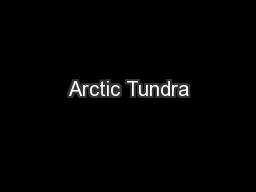

By Kevin Hayley and Caroline Northern Hemisphere Falls between 2 biomes Taiga and the Ice Caps Global Locations Artic Tundra Food Web 610 inches yearly mostly snow Summer sun 247 312 degrees Celsius ID: 375988
Download Presentation The PPT/PDF document "Arctic Tundra" is the property of its rightful owner. Permission is granted to download and print the materials on this web site for personal, non-commercial use only, and to display it on your personal computer provided you do not modify the materials and that you retain all copyright notices contained in the materials. By downloading content from our website, you accept the terms of this agreement.
Slide1
Arctic Tundra
By: Kevin, Hayley, and CarolineSlide2
Northern Hemisphere
Falls between 2 biomes: Taiga and the
Ice CapsGlobal LocationsSlide3
Artic Tundra Food WebSlide4
6-10 inches yearly (mostly snow)Summer
: sun 24/7 (3-12 degrees Celsius)Winter: several weeks no sun (-70 to -28 degrees Celsius)
Precipitation & Temperature RangesSlide5
Animals: Polar bear, caribou, arctic fox, snowy hare, musk ox, rock ptarmigan, narwhal, mountain goat
Plants: Artic moss, bareberry
, arctic willow, arctic poppy Common Plants & AnimalsSlide6
People living in tundra: air pollution from cities, drilling for resources
Overpopulation of Canadian geese: graze when vegetation is scarceGlobal Warming
: shrinks the tundraThreats to the BiomeSlide7
Hibernation: bears sleeping through winter
Fur: polar bears and caribou have hollow hairsBurrowing: hares and lemmings live underground
Body shape: shorter limbs, more compact frames reduce heat loss
Animal AdaptationsSlide8
Grow close to groundSmall leaves
Use as little energy as possibleExtremely resistant from coldPhotosynthesize from snow
Plant AdaptationsSlide9
Arctic moss: primary food source
Keystone SpeciesSlide10
Musk oxNarwhal
Both only live in Arctic Tundra
Unique CreaturesSlide11
Musk ox, narwhal, bearberry, polar bears, caribou, ptarmigan
Endemic SpeciesSlide12
Canadian geese: growing in population size
Canis lupus (the dog): active huntersBeaver: cut down trees, cause floods
Invasive Species Slide13
Tundra plants: willows, sedges and grasses, lichens, mossesCaribou and Reindeer: THE indicator animal species for the Arctic Tundra, Reindeer is the Old World form and is smaller and Caribou is North American form
Indicator SpeciesSlide14
Abiotic factors that influence tundra are strong winds, rainfall, short summer days, long and cold winters, and permafrost layer
Average winter temperature: -34 degrees C.Average summer temperature: 3-12 degrees C.
Important Abiotic Factors Slide15
A plant species in a nitrogen-limited, arctic tundra community were differentiated in timing, depth, nitrogen uptake, and this species dominance is strongly correlated with the uptake of most available soil nitrogen forms.
Examples of Resource Partitioning